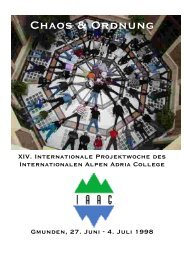ZEITREISEN - IAAC
ZEITREISEN - IAAC
ZEITREISEN - IAAC
Sie wollen auch ein ePaper? Erhöhen Sie die Reichweite Ihrer Titel.
YUMPU macht aus Druck-PDFs automatisch weboptimierte ePaper, die Google liebt.
to shoot his earlier self, then the gun will misfire or the bullet will simply miss. The cosmic censor, then,<br />
ensures that any and every attempt by the time traveler to alter his personal history will be frustrated.<br />
3. Parallel universes<br />
This possibility is more complex and involves the quantum rules which govern the subatomic level of<br />
the Universe. Put simply, when the time traveler kills the grandfather he immediately creates a new<br />
quantum universe, in essence a parallel universe, where the young grandfather never existed and<br />
where our time traveler is never born. The original universe still remains. Namely, if a time traveler<br />
journeyed into the past, and introduced the change, then reality splits into two directions, with one fork<br />
representing the change and other fork the original reality before change.<br />
This fantastic view actually has scientific plausibility, because of the so-called Many-worlds<br />
interpretation of quantum mechanics, pioneered by Hugh Everett in his 1957 Princeton doctoral<br />
dissertation. Recently, Stephen Hawking by applying the quantum mechanics to the cosmology,<br />
elaborated the similar idea, and he believes he can explain the origin of our Universe in a variation of<br />
this parallel-worlds theme. This brings us to the subject of Multiverse theory.<br />
Multiverse Theory<br />
Quantum cosmology: At first, it is contradiction in terms. World quantum applies to the infinitesimally<br />
small world of atomic and subatomic particles, while cosmology signifies the almost limitless<br />
expansion of outer space. However, Hawking and many other believe that the ultimate questions of<br />
cosmology can be answered by quantum theory.<br />
The starting point of quantum theory is wave function that describes all the possible states of a<br />
particle. As superbly illustrated in the Michio Kaku’s book “Hyperspace”, imagine a large irregular<br />
thundercloud that fills up the sky. The darker the cloud, the greater the concentration of water vapor<br />
and dust in the point. Therefore, simply by looking into the cloud, we can rapidly estimate the<br />
probability of finding large concentrations of water and dust in certain regions of the sky. The<br />
thundercloud can be compared to a single electron’s wave function. It fills up the space. Likewise, the<br />
greater its value in the point, the greater probability of finding the electron there.<br />
Hawking’s new idea is to treat the entire Universe as a single particle. We begin with a wave function<br />
describing the set of all possible universes. According to this picture the wave function of the universe<br />
spread over all possible universes. Therefore, it is more appropriate to speak of Multiverse as the<br />
entity consisting of all universes.<br />
Anthropic Principle and Philosophical Implications<br />
Multiverse theory raises philosophical and perhaps even religious questions. Over the centuries<br />
scientists have learned that the Universe is largely independent of human bias. Historically, early<br />
scientists often committed the fallacy of anthropomorphism, which assumes that the objects and<br />
animals have humanlike characteristics. However, there is some scientific merit to the debate over the<br />
anthropic principle which revolves over the indisputable fact that the physical constants in our<br />
Universe are tunned so precisely that they lead to the existence of (intelligent) life. If they were altered<br />
only by a smallest amount, life in the Universe would be impossible.<br />
Is this just a fortunate coincidence or does it show the work o Supreme Being? If Multiverse theory is<br />
correct, there are infinite number of parallel universes with different physical constants. On one such<br />
parallel universe (ours) the laws of physics are compatible with the life as we know it. If this is true,<br />
than perhaps the Supreme Being does not have to be evoked to explain why life, precious as it is, is<br />
possible in our Universe. Bluntly, according to Multiverse theory, life is statistically possible, or even<br />
inevitable in at least one of the parallel universes.<br />
What is the Price of a Time Travel Ticket?<br />
In principle, physics does allow time travel via closed timelike curves. But, traveling through time has<br />
been proved to be incredibly difficult. Princeton University physicists J. Richard Gott and Li-Xin Li at<br />
Princeton have speculated on whether space-time could both allow travel into the past and insure a<br />
consistent chronology (the traveler must remember shaking hands with his older self as he sets off).<br />
<strong>ZEITREISEN</strong> - 16. INTERNATIONALE PROJEKTWOCHE DES <strong>IAAC</strong> IN TANZENBERG SEITE 53





